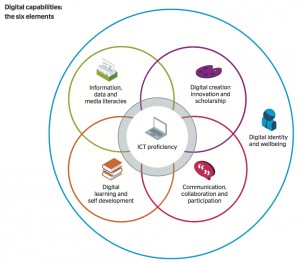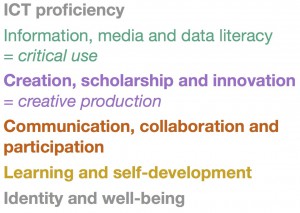It’s been a hectic, interesting and sometimes information-overloaded couple of months on the Digital Capabilities frameworks project. Lou McGill and I have reviewed over 60 existing frameworks for describing the digital capabilities of staff, from professional frameworks which might only touch on digital practice, to frameworks from the IT industry, digital media, and business innovation. We’ve looked at a host of publications and web sites. And I’ve carried out interviews with dozens of people who are doing work in this area, whether they are based in professional bodies or in universities and colleges, or in industry and the professions outside of education.
One of the surprising things to emerge from this process, as Sarah Davies has outlined, is the affection people feel for some of the work Jisc has already done in this area. The ‘7 elements of digital literacy‘ and the Digital Literacy Development pyramid for example, are widely recognised and have been used to develop a host of local solutions. This isn’t to distract attention from the value of other frameworks such as SCONUL’s seven pillars of information literacy (and its various lenses), CILIP and CMALT as professional standards for (respectively) library and e-learning staff, the information lens on Vitae’s Researcher Development Framework and the digital lens on the UK Professional Standards Framework for teaching staff, or the work of ETF/Coralesce in support of FE colleges. But it does suggest the value in having an over-arching set of terms that are reasonably consensual. And also that updating them might lead to a bit of resistance!
 Six elements of digital capability: click for more detailed view
Six elements of digital capability: click for more detailed view
Happily my experience so far has been a positive one. People recognise that these ideas need to be revisited if they are to stay relevant and fresh. So the proposed new model has already been through a process of consultation with stakeholders and now we’d like to know what you think of it. Why might an update be a good idea at this point, and how might a framework of this kind being used in your setting?
One of the most obvious differences is that the different areas visibly overlap. This was a clear message from users, who described a ‘venn diagram‘ or ‘flower with overlapping petals‘ as more appropriate than the current ‘hub and spoke’ image. Another difference is that ICT proficiency is placed in the centre, as a foundational set of skills giving access to all the other elements. Digital identity (now paired with ‘wellbeing’) embraces the rest. This merges the ‘elements’ of digital literacy with the pyramid model, showing basic ICT operations as foundational, and digital identity as the capstone or culmination of the other digital practices.
‘Information literacy’ and ‘media literacy’ have been brought together, along with ‘data literacy’, which has become much more important since the original 7 elements were conceived in 2009 as an outcome of the LLiDA project. This gives us 6 elements, which some expert commentators felt was both more memorable and easier to apply into practice. The other change is the inclusion of ‘wellbeing’ alongside digital identity. Interviews for this project, and research from others (such as Digital Student) found that digital practices could be a source of stress and concern, as well as having more positive associations of professionalism and innovation. Issues raised by staff include workload, a culture of constant availability, and the lack of time to really explore and understand digital approaches. Issues raised by students revolve more around exposure and cyberbullying, the fear of losing face to face contact time, and managing time/attention in digital spaces. Everyone can suffer if digital technologies are used without attention to human and environmental health, and without considering whether digital practices are fully inclusive and equitable. So although many of these issues require action at an organisational level rather than an individual level, we feel it is important that individuals are aware of how digital technologies may impact on different areas of their lives.
There is a more detailed breakdown of the six elements and an explanation for the changes in the three documents attached to this post. Feel free to comment and to download or use this as you like – bearing in mind that they are still in development. They are not editable documents at this stage while we explore with a number of institutions and professional bodies how they would like to take forward the ideas. But bear with us – richer and fully adaptable versions are coming very soon!
1. Digital capabilities 6 elements. Includes: core model; visual; rationale for proposed changes to the ‘7 elements’ and response to feedback on an earlier draft; example profiles (a) learner profile (b) teacher profile (c) researcher profile.
2. Landscape review. Issues in the techological, educational and organisational environment that institutions are responding to over the coming years and beyond; response to feedback on an earlier draft.
3. Frameworks mapped to 6 elements. A wide variety of formal frameworks and less formal definitions, supporting more detailed development of the six elements for different professions, subject areas, and organisational settings.
With grateful thanks to all the individuals and professional bodies that have been involved so far. I’m sure they would all agree that what matters is not so much the outcome but the process of sharing our ideas and challenges in this space. If a framework for digital capabilities has any value it will be to inform change initiatives in universities, colleges and professional bodies. The next phase is to consult on what those should be and how Jisc can best support them.


5 replies on “Revisiting digital capability for 2015”
It is great to hear that people found the original 7 elements so useful, but very timely to reconsider this. Personally I really do prefer the venn-type diagram because the overlaps have always been there and the boundaries have always seemed to me to be problematic (particularly in relation to the different responsibilities for these areas within institutions). I also really like the bringing together of information, media and data literacies (as someone with a background in supporting and teaching in these areas in the past). I look forward to see how people respond to this fresh view.
having just read the LLiDA report I do prefer these revised literacies, it did not need to be 7 although that was an excellent foundation. Although probably implicit in the diagram via communication, collaboration, innovation and learning I am left hankering for something overtly articulating the contribution of the individual to ‘organisational learning and development’ that, in any sensible organisation, goes hand in hand with an individual’s self or personal professional development.
Hopefully I am not being overly semantically pedantic but I also wonder about the inclusion of ‘digital’ within the diagram – it is implicit in the title that the competencies are expected to be digitally enabled or related in some way. If not needed appended to ‘Communication, collaboration and well-being’ why is it needed with ‘Identity and well-being’?
Hello Ian, thanks for your comments. The point about teams and organisations has been made by others too. In the notes to the framework and instances I’ve made clear that the purpose is to define individual capabilities. This allows digital capability to be incorporated into existing practices that focus on the individual, such as staff development, CPD, appraisal, personal development planning, role analysis and job decription etc. etc. But the same resources can be used to support the development needs of teams and organisations and Jisc is looking at diagnostic tools, based on the framework, that will work at this level. btw the new definition of ‘innovation’ explicitly includes ‘organisational change’ and the contribution that individuals make to this.
Re. ‘digital’, I’m interested to define what specific capabilities are required for people to be effective in a digital organisation and world. From my own experience and from reviewing the literature, attempts to do this often fall back into a narrow set of skills around manipulation of the actual devices and tools, or on the other hand become so extensive that they no longer describe what is distinctively digital. I have tried to use terms that focus on what is distinctive, even if they are taken out of the context of the overall diagram. I’ll look again and see if there is a more consistent way I can do this without it becoming too wordy.
The work you’ve done has been great.
We here at my university are currently in the process of mapping all our staff training to the 7 elements of digital literacy, plus our own internal behaviours and values, the UKPSF framework, Vitae and the AUA CPD framework. All of which is a lot trickier than we thought!
When do your changes above go live? Or are they just proposed at the moment?
Hi Jim, I’ve emailed you separately but thanks for your comment. The changes are effective in as far as this is the model Jisc is promoting, but the 7 elements of digital literacy is in no way ‘wrong’. There are many continuities. This is an update and a broadening out of that agenda to explicitly include staff. Several other universities are engaged in this mapping process and we will certainly report on how they get on and any outcomes they want us to share.